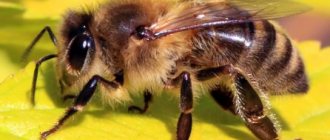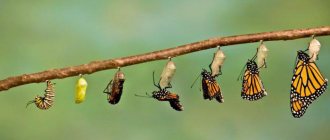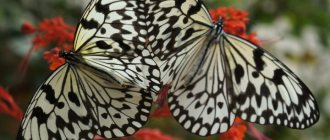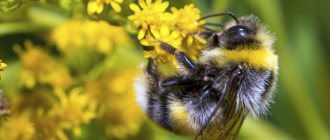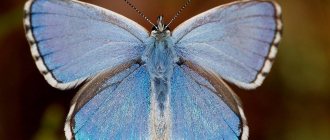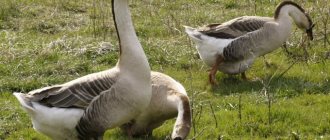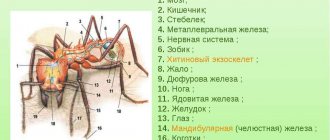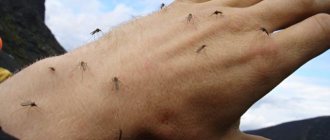Features of reproduction
Insects are characterized by sexual dimorphism, that is, it is quite easy to distinguish between a male and a female by appearance. They have different sizes (in many species, females are several times larger than males), differ in color, and the length of their antennae. In some butterfly species, females do not have wings.
Communication between opposite-sex representatives of a species occurs in various ways:
- Using behavioral characteristics.
- Sound and color signals.
- Chemically - by releasing pheromones.
In certain species, contact between a male and female is not required for fertilization; these are lower insects whose habitat is rotten wood or soil. How do insects reproduce in this case? Males leave drops of sperm on the ground, and females capture them with special organs (genital appendages) located next to the genital openings. This is precisely the method inherent in representatives of the class with incomplete transformation:
Other insects reproduce by mating individuals of different sexes, a phenomenon called copulation.
Most representatives of the class are characterized by reproduction with the participation of individuals of both sexes, but there are exceptions in nature.
Types of butterflies
The color of butterfly wings is varied. In some they are beautifully and brightly colored, while in others, on the contrary, they have a modest protective color, allowing them to be invisible on flowers and herbs, tree bark, stones, and lichens. Many species are characterized by sexual dimorphism, that is, a pronounced external difference between male and female in color, shape and size of wings, as well as in the structure of the antennae. Occasionally there are individual, atypically colored individuals called aberrants.
Gynandromorph butterflies, that is, individuals that combine the characteristics of a male and a female, are extremely rare. Gynandromorphs of species that are characterized by pronounced sexual dimorphism look very unusual. In this case, on one side of the butterfly’s body there are wings with the color of the male, and on the other - with the color of the female.
Most butterflies are active at dusk and at night, with a much smaller number of species active during the day. However, it is the diurnal butterflies that are the most visible, and, as a result, the best studied. Many butterflies are good flyers; some species are characterized by regular migrations, which often leads to their wide distribution. Others, on the contrary, inhabit only small geographical regions; such species are called endemic.
Methods
There are five main ways in which insects reproduce. Information about them is presented in table form.
Description of insect reproduction methods
Its brief description
The development of the embryo occurs in the body of the mother, and a larva or prepupa is born.
Some types of flies and gadflies
Individuals of both sexes participate in the process, mating and egg laying occur. A large number of insects reproduce in this way.
Reproduction is at the larval stage; larvae develop in her body, which eat the mother’s body to escape. The method is typical for Coleoptera or Hemiptera and often alternates with gamogenesis.
Some types of gall midges
Virgin reproduction, without fertilization.
Honeybee, some Hymenoptera
Otherwise, this method is called multi-embryonic reproduction; it occurs at the egg stage. This method is typical for Hymenoptera parasites: a parasite egg is laid in the embryo of the host egg.
These are the main methods of reproduction of insects found in nature.
Parthenogenesis
Let's consider which insects are capable of reproducing parthenogenetically. These are stick insects, some types of beetles, scale insects, aphids, many types of wasps, ants and bees.
Capable of such reproduction:
- Males, in this case, the phenomenon is called arrhenotoky.
- Females, we are talking about thelytoky.
- Both of them are amphitokia.
It is customary to distinguish several types of parthenogenesis, the differences of which are presented in the table.
Varieties of parthenogenesis
It is partial in nature and occurs only under the influence of external factors or under a special condition of the female.
A striking example is the reproduction of aphids. There is an alternation of generations: virgin and bisexual; in this case, the offspring of a female who has not received fertilization consists of females for a long time, but the growing season always ends with amphitokyy or arrhenotoky.
Most often observed in closed ground conditions, under optimal external conditions, in the absence of the need to proceed to reproduction with the participation of both sexes.
This method of reproduction has adaptive significance; the process involves an individual of only one sex, which helps insects survive even in unfavorable external conditions.
Stages of development
Let's look at how insects reproduce and develop. If the reproduction process can take place both with and without fertilization, then development goes through several stages:
- When the transformation cycle is incomplete, it includes three stages: egg - larva - adult (in science called imago). In this case, the structural features of the larva practically do not distinguish it from the imago.
- The complete transformation cycle involves four stages: egg - larva - pupa - adult. The larvae differ significantly from adult insects.
These are the phases of insect development. The larva can molt several times, gradually increasing in size.
Butterfly development - video
Butterflies are insects with the so-called full cycle of transformations. Between the larval (caterpillar) stage and the adult (butterfly) stage there is an intermediate pupal stage. And the whole development can be represented like this: egg - caterpillar - pupa - butterfly.
Most day and night butterflies produce one generation per year, with adult butterflies only found for a few weeks at certain times of the year and then disappearing again until the following year. The offspring left by butterflies overwinter in the egg, caterpillar or pupa stage, depending on the type of butterfly. Some butterflies - the buckthorn, the day peacock's eye and others - overwinter in torpor at the imaginal stage. Adults of these species are found throughout the year. Many butterfly species produce two generations per year. In this case, adult insects appear in late spring and again in summer. Caterpillars that emerge from eggs laid in the spring grow quickly, but caterpillars that emerge in the summer may not develop into butterflies until nine months later. Butterflies that produce one generation per year in the northern regions, in the south can lay eggs two or even three times a year. Butterflies living in the mountains usually produce one generation per year. Some butterflies living in cold climates manage to complete development in only two years, the same is typical for caterpillars living in wood and on roots.
When is it dangerous to help? The story of a butterfly...
One day a man found a butterfly cocoon and took it home. He decided to observe the transformation process. The cocoon opened, and for several hours in a row this man observed the difficulties the butterfly had to go through in order to get out. She tried to get out through the small hole for quite a long time and suddenly the moment came when it seemed to him that the butterfly had given up and stopped fighting. It looked like she was stuck and completely motionless. Taking pity on her, the man decided to help her and cut off the cocoon. Thanks to this, the butterfly got out of the cocoon, but its body was swollen like a caterpillar, its wings were small and unopened. The man expected her wings to strengthen and grow and her body to transform, but nothing else happened. The butterfly pitifully dragged its swollen body in a circle, now doomed to do this for the rest of its life. Man, out of his kindness, did not understand that he had interfered with the natural process of nature. The efforts that the butterfly made were simply necessary for metamorphosis. Making its way through the narrow opening of the cocoon, the liquid from the butterfly's body would pass into the wings, making them large and strong for flight. By depriving the butterfly of its struggle, man doomed it to a miserable existence and deprived it of a wonderful future. Likewise, people become strong and successful and transform into a better image only when they go through certain difficulties and put in a lot of effort.
The life cycle of butterflies consists of four stages: egg, larva, pupa and adult. Butterflies are insects with the so-called full cycle of transformations, since the larva is completely different from the adult. The transition from one stage to another, or transformation, is called metamorphosis.
Testicles
- This is the first phase of insect development. The testicles must be kept safe and sound, so butterflies take care of this, some lay them in the soil, others fill the testicles with gland secretions, which harden in the air - a capsule is obtained, the capsules are usually camouflaged to match the color of the surface. Another method is that insects cover the testicles with hairs or scales that are scraped from the abdomen. The female lays eggs in batches that can contain several eggs or can reach hundreds of eggs. Depending on the species, they are arranged in layers, in a line or in a ring around the shoot of the plant on which the caterpillars will feed. In some species, the female disperses the eggs in flight. The development of the embryo depends on climatic conditions and can last from several days to several months, especially when the insect overwinters at the egg stage.
Larvae emerge from the testicles - caterpillars
. They actively feed, grow and accumulate substances for the next transformations. The caterpillar has three pairs of segmented legs armed with claws, and several (up to 5 pairs) false legs equipped with bunches of claws, which allows it to hold well on a support. Caterpillars of daytime butterflies are very diverse in color and external structure. They have a gnawing mouthpart and, for the most part, feed on the leaves of various plants. Caterpillars grow quickly. Gradually, the outer covers (cuticles) of the larva become too tight for it, and they need to be replaced. Molting occurs, which is preceded by a period of growth. Most larvae have 5 of them, or even more if the larva overwinters. Therefore, the lifespan of a larva can reach from several weeks to several months, and for woodworms up to 2-3 years.
At the last molt, the caterpillar turns into a pupa
. The coloring and body shape of butterfly pupae are no less varied than those of caterpillars. Butterfly pupae do not feed or move; they are usually attached to branches, leaves, various objects (the so-called “belted” and “hanging” pupae), or lie freely on the soil - among fallen leaves and in the soil litter. The duration of the pupal stage can vary from several weeks (in some tropical species) to nine months or more (in temperate climates with long winters). During this period, organs and tissues change and acquire features characteristic of adults, wings and muscles are formed.
A butterfly emerges from the pupa. Adult butterfly (imago)
quickly reaches sexual maturity and is ready to reproduce within a few days. Depending on how quickly the butterfly fulfills this main purpose, it lives from several days to several weeks. The exception is wintering butterflies, which can live more than 10 months.
Butterflies are lepidoptera, belonging to insects that have a full cycle of transformation. Their distinctive feature from other representatives of the order is the presence of chitinous scales on the hind and fore wings. These elements have the finest optical components, which, when interacting with ultraviolet light, make it possible to see a range of colors that the human eye cannot perceive.
To find out how a butterfly develops, you first need to understand what the cycle with complete transformation includes. This process contains the following stages:
- egg stage;
- caterpillar (larval) stage;
- pupal stage;
- stage of an adult insect (imago).
Just as butterflies develop, other representatives of lepidoptera - moths and moths - also turn into adults.
Features of eggs
We looked at how insects reproduce. Now we will find out what is peculiar about their development at each of the phases.
The eggs of representatives of the class are covered with two shells and have a wide variety of shapes, colors and sizes. The most common forms found in nature are:
For example, the eggs of butterflies and flies are most often oval, while those of bedbugs are in the shape of an almost regular ball. Most often they are laid in small groups - oviposition, but in some species they can also be laid singly.
Types of butterfly eggs
Butterfly eggs come in various shapes - round, flattened, oval, spindle-shaped, smooth or with a cellular surface, covered with spines or ribs. The color of the eggs is also different, most often whitish, light green or yellow, in addition, brownish, brownish-violet, reddish. The eggs of many species change color as they develop.
The manner in which eggs are laid may differ among different species of butterflies. Eggs can be laid one at a time or several at a time, or in large groups, up to several hundred in one clutch. Eggs can be laid on leaves, stems, flowers, fruits of plants, in cracks in tree bark, on soil, lichens, and on dry plant remains. After laying, females of some species cover their eggs with hairs from their abdomen.
Classification of larvae
According to the type of larvae there are:
- Imagiformes (nymphs) – in insects with incomplete metamorphosis. As previously mentioned, they are not much different from adults, hence the name. Most often they lead a lifestyle similar to adult individuals and eat the same.
- Representatives of the class with complete transformation have non-imaginous ones. They have a simpler structure of eyes and limbs than adults, and may have a completely different mouth structure.
Non-magicoids, in turn, are divided into three types:
- Campodeoids - resemble adults, are quite active, and are often predators.
- Worm-shaped. Such larvae are large, their body is practically not divided into sections, their legs are short or may be completely absent.
- Caterpillars are distinguished by the presence of several pairs of appendage legs.
These are the main types of larvae of representatives of the class of insects.
Curious facts
Having learned how insects reproduce, let’s get acquainted with a selection of interesting facts:
- Bees mate only once in their lives.
- In mosquitoes, mating occurs in the fall, but females lay eggs only in the spring, that is, quite a long time passes between copulation and fertilization.
- Almost all insects are capable of reproducing parthenogenetically under certain circumstances, with the exception of dragonflies and bedbugs.
- The mating process of ladybugs can last more than 10 hours.
- After mating, the female praying mantis often eats the male to compensate for the lack of nutrients in the body.
We looked briefly at how insects reproduce. There are quite a few ways, they help populations survive and spread, despite unfavorable environmental conditions.
Many insects are characterized by sexual dimorphism, that is, males and females differ in color, size, and even the ability to fly. After fertilization, females lay eggs. They can be solitary or form groups. After a few days or weeks, the eggs hatch into larvae, which, after one or more molts, develop into adult insects. This development is called metamorphosis or transformation. This happens primarily because the growing insect needs to get rid of its outer chitinous skeleton. Moreover, some larvae can live for many years, and adult insects can live for several weeks or even days.
Imago - adult stage of individual development of insects
Complete transformation
In many insects, such as butterflies, beetles, flies and bees, the larvae are not similar in appearance and in the way they feed to the adults. The larvae grow, molt several times, then secrete threads from which they build a cocoon and become pupae. In the cocoon, the pupa does not feed or move. Its organs are rebuilt, wings grow, and a beautiful adult insect, the imago, emerges from the cocoon. This development of insects is called complete transformation.
The reproduction and development of insects is subject to its own laws, which are largely different from the same processes in other representatives of the phylum Arthropods. Insects reproduce with or without fertilization, and their development can occur in a different number of stages. Interestingly, the life cycles of insects such as aphids have a more complex periodicity. Another specific feature of the development of insects is the diapause stage, which is not characteristic of all representatives of the Animal Kingdom.
Structure
However, despite the variety of forms, a common distinguishing feature of this group is the presence of three pairs of legs on the thoracic segments. Hence the second name of the superclass - Hexapoda, that is, “six-legged”.
External structure using the example of an adult antlion: 1 - head 2 - chest 3 - abdomen 4 - eyes 5 - antennae 6 - hypostigma 7 - pterostigma
On top, the body of insects is usually covered with a chitinous shell, the cuticle, which in these animals serves as an external skeleton. As a rule, an adult insect (imago) has a body consisting of a head, thorax and an eleven-segmented abdomen. Six legs are attached to the thoracic region, and winged insects also have wings.
Head structure
Insects breathe using the trachea system or the entire surface of the body.
Nervous system
The nervous system consists of a series of nerve ganglia, or ganglia, from which nerves arise. In higher insects, the number of ganglia decreases due to their combination to 2–3 or even one, which is associated with their complex behavior.
The digestive system of insects is also characterized by a number of common features. Its basis is the digestive canal, morphologically (in structure) it consists of the foregut, middle and hindgut. Depending on the food consumed and the method of digestion, the length of the digestive tract and the development of its individual parts differ in different insects.
Ancient primitive (wingless) insects appeared 350-400 million years ago during the Devonian period. Winged - 280-350 million years ago. Insects are very diverse creatures. They differ not only in appearance, but also in their biology, individual development, types of transformation, means of adaptation to the environment, and care for their offspring.
How insects reproduce: gamogenesis and parthenogenesis
To begin with, it is worthwhile to dwell in detail on how insects reproduce.
The vast majority of insects are characterized by gamogenesis - a method of sexual reproduction with fertilization. In addition, in certain groups of insects there are other methods. Parthenogenesis is sexual reproduction without fertilization (virgin), in which females, without the participation of males, give birth to offspring by laying eggs or giving birth to larvae. There is obligate parthenogenesis, characteristic of some species of stick insects, scale insects, beetles, etc.; facultative, occurring in individual females or part of their offspring; cyclical, alternating with gamogenesis in generations of the life cycle (aphids). Through parthenogenesis, only females can develop (thelytoky - in an obligate form and in most generations in aphids), only males (arrhenotoky - in a facultative form in many wasps, bees, ants) and both sexes (amphitoky - in one generation in aphids). Polyembryony is the phenomenon of the development of not one, but many embryos in an egg, from which a group of larvae ultimately emerges, and is found in some parasitic Hymenoptera (ichneumon parasites). Pedogenesis is larval reproduction, in which eggs are formed in the body of the “mother” larva and, through parthenogenesis, “daughter” larvae emerge. Found in some gall midge mosquitoes. Viviparity, in which females do not lay eggs but give birth to larvae, occurs in different groups of insects. In many aphids, it accompanies parthenogenesis and is associated with very rapid development of eggs, ending in the female’s oviducts. In some blood-sucking flies, the larvae develop for a long time in the mother's body and, having hatched, soon pupate.
Phases of insect development with complete and incomplete transformation
In insects, there are two main types of development, according to which they are divided into two large divisions. The development of insects with incomplete transformation takes place in three phases: egg - larva - imago (adult insect), and is not accompanied by sudden changes. The larvae are similar in structure to adult insects and turn into them immediately after the end of development and the last molt.
Another type is the development of insects with complete transformation; it occurs in four phases: egg—larva—pupa—imago. Larvae differ sharply from adults, therefore, at the end of this phase of insect development, they turn into the resting pupal stage, in which the transformation of the body organization from larval to imaginal occurs.
Egg stage
The first thing in a butterfly is an egg. In butterflies they have a varied shape and a fairly hard shell. They are angular, round, spherical. Their outer surface is embossed with symmetrical tubercles and depressions. The color scheme ranges from white to green, and sometimes there is a colored pattern on the outer surface.
Typically, females can lay more than 1,000 eggs in one clutch. Depending on the species of these insects, they can leave them either in a group of up to 10 pieces, or individually. The egg stage lasts from 8 to 15 days.
Where do insects lay eggs, their shape and structure
Female insects lay eggs in a wide variety of places suitable for further development of larvae: on the above-ground parts of plants, inside plant organs, in plant litter, on the surface of the soil, in the soil, in special underground or above-ground nests, in decomposing organic substrates, on the surface or the bottom of reservoirs, onto or into aquatic plants, as well as into the body of the host animal.
The fertility of insects, i.e. the number of eggs laid by a female during her life, is very diverse. In some species it is small - on the order of several dozen eggs, in most it is about several hundred, in some it is several thousand, and finally in mature females of social insects it reaches about millions. In some insects, females lay eggs singly or scattered, but most lay them in groups - oviposition. The size of the oviposition in which insect eggs develop can vary from a few pieces to several hundred eggs. Some insects have a strictly fixed amount of oviposition, for example, 12 eggs in many stink bugs, but for most it is highly variable. Of the special forms of oviposition, it should be noted ootheca - egg-laying cockroaches in special leathery capsules, egg capsules - soil oviposition of locusts, enclosed in dense earthen capsules, oviposition with felt pubescence of moth butterflies, covered with hairs from the abdomen of the female.
Types of insect eggs, methods of laying them.
⇐ PreviousPage 7 of 7
An insect egg is a large cell. protoplasm (fills the entire inside of the egg), the outside is covered with chorion - a membrane that protects against various damage. Under the charyon lies the vitelline membrane, on the surface of the chorion a micropyle is found - (an opening used for fertilization
2. The sizes and appearance of eggs are very diverse:
In aphids, thrips, phylloxera from 0.02 - 0.03 mm in length, in locusts 8-10 mm, in grasshoppers up to 15 mm, 8-10 mm. at the bear's. By form:
1. Sickle-shaped - locusts
2. Barrel-shaped - bedbugs
3. Fusiform flies
4. Bottle-shaped - whites
5. Hemispherical - scoops
6. With a stalk - in lacewings, honeydews
7. Lozenge-shaped - meadow moth. By color: color depends on the type of insect. Freshly laid eggs have a milky white color, and after some time they acquire the color characteristic of this species: orange for the Colorado potato beetle, yellowish eggs for the cabbage white beetle, white for the fly. Eggs are laid in the same variety of ways:
1. Alone – codling moth, sawflies
2. In groups or clusters - the Colorado potato beetle
If eggs are laid in certain groups, then such groups are called clutches of eggs.
The clutches are: 1. Regular rows ::: (cruciferous bugs). 2. In the form of rings on annual shoots: ringed silkworm.
The clutches are of an open type - on the surface of leaves and other parts of plants (Colorado beetle)
Closed type:
The eggs are covered with down from the female's abdomen - gypsy moth, lacewing.
In the shape of a capsule - a locust.
Collected in a mosquito-like shell - or a special capsule - ooteca (cockroaches).
Insects can lay different numbers of eggs, which depend on the type of insect and on the conditions: fertility of the com. From 200 to 3000 pieces; mole cricket from 150 to 300, aphids from 2 to 10 eggs.
80. Beet flea beetle and measures to combat it. Beet flea beetles - systematic position: order Beetles, or Coleoptera, family leaf beetles (Chrysomelidae).
Beetroot is damaged by several types of flea beetles, which have similar developmental features, but different zones of harmfulness and a range of damaged crops. The common beet flea beetle, Chaetocnema concinna Marsh, is ubiquitous; the range of food plants, in addition to beets, includes flax, hops, various types of goosefoot, buckwheat and cabbage. Southern beet flea beetle - SL. breviuscula Fald. damages beets and goosefoot weeds in the Central Black Earth, Volga, North Caucasus, Ural and West Siberian regions. In the south of the European part of Russia, beets are damaged by the Western beet flea beetle - SL. tibiales 111. Widespread root flea beetle - Psylloides cupreata Duft. damages beets, rutabaga and turnips in the West Siberian and Far Eastern regions.
Beet flea beetles are small, 1.5-2.5 mm long; the body is oval, convex, black with various metallic shades: from copper-bronze to blue-green; 11-segment antennas; Hind legs are jumping. Species differences between flea beetles are based on the structure of the pronotum and the punctation of the head.
Adults overwinter on the soil surface under plant debris. The usual wintering places are the edges of forest belts and other tree and shrub vegetation. In the spring, overwintered beetles begin to feed additionally on goosefoot and buckwheat weeds, and later colonize beet seedlings. During this period, flea beetles cause the most serious damage to plants, gnawing numerous small pits and through holes on the leaves. The leaf blade dries out and crumbles. The harmfulness of beetles especially increases in hot, dry weather and often leads to massive death of beet seedlings.
After mating, females lay 4-12 eggs in the surface layer of soil near food plants. The fertility of flea beetles is 200-240 eggs. The embryonic period lasts 11 - 13 days, after which the hatched worm-like larvae begin to feed on the roots of goosefoot and buckwheat plants without causing them significant harm. The larvae develop for no more than 1 month; beet flea beetles pupate in the soil. The beetles emerging at the end of summer feed briefly on weeds and cultivated plants, after which they move to wintering areas. The common and root flea beetles develop one generation per year; in the southern regions, the western and southern beet flea beetles can develop a second generation.
The number of beet flea beetles is influenced by many types of parasitic nematodes, causing the death of larvae or a significant decrease in fertility in females. Mass epizootics caused by entomopathogenic fungi are often observed in flea beetle populations.
⇐ Previous7
Recommended pages:
Adult stage of insect development: molting of larvae
The main functions of the larval phase are nutrition, growth, development. In the adult stage of insect development, the larva is the only growing phase. Its size can increase tens and hundreds of times. Therefore, the larvae molt several times, shedding the old cuticle in the form of a larval skin and at the same time forming a new one. The stages of insect larvae between molts are called larval instars. Thus, a larva of the first instar appears from an egg, after a period of growth and the first molt it turns into a larva of the second instar, etc. The number of molts and larval instars, constant for each species, in general for most insects varies between 3-8, however in dragonflies it reaches 15-20, and in mayflies - 25-30. The initial instars in the development of larvae are often called younger, the latter - older. In addition to size, larvae of different ages differ in body proportions, development of appendages, and sometimes color. The characteristics of insect larvae at all stages of development are very diverse; diagnostic systems have been developed based on them, making it possible to identify species no less clearly than using the adult phase. In insects, there are four main types of larvae.
Types of insect larvae: imago and campodeoid
Adult-like larvae, or nymphs, are insect larvae with incomplete metamorphosis. They are similar in structure to adult insects: they have three pairs of well-developed legs on the thoracic region, compound eyes, a mouthpart similar to that of an imago, and well-developed antennae. They have external wing rudiments. Typically, the larvae of insects of the imago type are also similar to the imago in their lifestyle and feeding pattern. Pests with incomplete transformation of larvae and adults always damage plants in a similar way. Some exceptions are the water-living larvae of dragonflies and mayflies, which have aquatic breathing organs - tracheal gills. They are sometimes called naiads.
Insect larvae with complete metamorphosis, sometimes called true ones, can generally be designated as non-imaginous. These larvae may have a different number of limbs, which are less developed than those of adult insects; or they are missing. The larvae lack compound eyes; simple ocelli serve as visual organs. They lack external wing rudiments, the antennae are short or undeveloped, and the oral apparatus, most often gnawing, may have a completely different structure than that of the imago. Insect larvae with complete metamorphosis can differ sharply from the imago in their lifestyle and feeding pattern. In pests with complete metamorphosis, damage can be caused by either the larva, the adult, or the organism at both stages of development. In insects with complete metamorphosis, three types of larvae are distinguished.
Campodeoid larvae (from the Latin name of the primary wingless insect Campodea, which resembles this type). The larvae are active, often predatory, with developed body appendages. They have well-developed three pairs of thoracic legs, fully articulated, their length usually exceeding the width of the body.
Look at the photo - this type of insect larvae has relatively clearly distinguished thoracic and abdominal sections, developed antennae, and large upper jaws:
The integument is usually pigmented. This type of larvae is found in some families of beetles (ground beetles, rove beetles, ladybugs) and in all lacewings.
Types of insect larvae: worm-like and caterpillar-like
Worm-like larvae are a very large and heterogeneous group. Their body is elongated, weakly divided into thoracic and abdominal sections. Three pairs of thoracic legs are short or absent. Based on the presence of legs and the development of the head, three forms of worm-like larvae are distinguished. Larvae with heads and legs are found in a number of families of the order Coleoptera and have a very diverse appearance.
The larvae of lamellar beetles (beetles and dung beetles) are thick, C-shaped; leaf beetle larvae are noticeably convex on top; The larvae of click beetles and darkling beetles (wireworms and pseudowireworms) are long, thin, cylindrical, with compacted integuments. Larvae with a head and without legs are also found in some families of Coleoptera (golden beetles, longhorned beetles, weevils), in most groups of the order Hymenoptera (ichneumon fly, wasps, bees, ants) and in part of the order Diptera (most mosquitoes). Larvae without legs and an outwardly defined head are found only in the order Diptera (most flies). The head section of these larvae is retracted into the prothorax, the head capsule is underdeveloped.
Caterpillar larvae have an elongated body and a large number of short legs. Unlike other insect larvae, this species, in addition to three pairs of thoracic legs, has several pairs of accessory abdominal legs. These short, undivided larval appendages do not appear in adult insects.
There are two forms of caterpillar insect larvae. True caterpillars - lepidopteran larvae - have from 2 to 5 pairs of abdominal legs. The caterpillars of most butterflies have 5 pairs of legs located on the 3rd-6th and 9th abdominal segments. However, in caterpillars of some families, the number of abdominal legs is reduced to 4 (crested moths), 3 (metal moths), and 2 pairs (moths). False caterpillars are the larvae of some families of sawflies, representatives of the order Hymenoptera. They have a larger number of abdominal legs - 6-8 pairs.
Development of insects in the pupal stage: types and structure (with photo)
In insects with complete metamorphosis, the larva, having completed development, turns into a pupa. The larvae of most insects pupate in the soil, sometimes openly on or inside plants. The insect pupa is a resting stage of development, but intensive processes take place in its body: the disintegration of larval organs and tissues and the formation of organs and tissues of the imago. By the end of development, the pupa acquires the main structural features of an adult insect: developed wings, legs, antennae, adult mouthparts, compound eyes.
Transformation of a caterpillar into a butterfly - the pupa stage
Pupation is the most vulnerable process in the butterfly's development cycle, and most caterpillars prepare carefully for it. The pupal stage in different species can last from several days to several years. A long pause (stop in development) of pupae is an adaptation that allows the species to survive unfavorable years. If in the first year unsuitable conditions arise and the butterflies emerging from the pupae die, the population is replenished by previously diapausing pupae that emerge the next year.
The butterfly formed inside the pupal shell has very short, soft wings. When emerging from the pupa, it needs to climb onto some vertical surface in order to hang its wings, which will give them the opportunity to straighten. After which the wings gradually harden, and during this time the butterfly sits motionless.
The butterfly's body consists of three sections - the head, thorax and abdomen, which contains internal organs.
The head bears antennae, palps, complex compound eyes and mouthparts. The vast majority of butterflies have mouthparts of the sucking type and are a thin long tube-proboscis, which is curled into a spiral when at rest. Many butterflies have underdeveloped mouthparts and are thus unable to feed, subsisting on energy reserves accumulated during the caterpillar stage.
The antennae of butterflies are an organ of smell and come in various shapes - filamentous, club-shaped, feathery, comb-shaped and others. The sense of smell of some butterflies is very developed; males of such species are able to detect the scent of a female at a considerable distance.
The chest of butterflies bears three pairs of jointed legs and two pairs of wings, while the females of some species have underdeveloped wings or are completely wingless, and in some species they are also legless. The pattern on the wings of butterflies is formed by the scales covering them, hence the scientific name of the order - Lepidoptera.
Life cycles of univoltine and polyvoltine insects
The life cycle of insect development is a repeating time sequence of development and reproduction processes. The main measure of the life cycle of insects is generation, or generation, the period of complete development from egg to adult sexually mature insect. Depending on the time of generation development, three groups of insects with different types of life cycles are distinguished.
Monovoltine insects are those that develop exactly one generation per year, regardless of external conditions. Monovoltine species are often found among Orthoptera, bugs, beetles, etc. Multivoltine insects are capable of developing in several generations per year. The number of generations is determined by the biological characteristics of the species and weather and climatic conditions. Each species is characterized by a certain but varying number of generations. Thus, the Colorado potato beetle usually produces from 1 to 3 generations per year, the cabbage white bug - 2-5, and many species of aphids - about 10-15. Multivoltine species are often found among butterflies, dipterans, etc. The third group is formed by insects with multi-year generation, the development of which takes more than one year. These include some beetles, cicadas, dragonflies, etc. Thus, bread beetles have a 2-year generation, and generations of click beetles develop in 4-5 years.
Meaning in human life
Butterflies from the genus Morpho are considered the most beautiful. In the photo: newly hatched Morpho peleides (lat. Morpho peleides)
Since ancient times, man has suffered from insects, most of which have a huge ability to reproduce. Insects should be considered the most serious competitors of humans in terms of food and industrial raw materials, since they feed on the same natural products as humans. In addition, many insects can cause great harm to our health. However, not all insects are harmful. Among them there are many useful ones, such as bees, which give us a valuable product - honey - and pollinate plants. Pollinators also include some wasps, flies and beetles. Another group of economically useful insects consists of a large number of predators and parasites of insect pests. These include ichneumon wasps, parasitic wasps, and ladybugs, ground beetles, fire beetles, and mantises.
All articles
Life cycles of aphids
Among insects, aphids have the most dynamic and complex periodicity of development. Aphids are one of the record holders for the speed of development; many of them give 10-15, and sometimes up to 25-30 generations per year. In the annual cycle, there is a natural alternation of types of reproduction, morphological forms, and in some species, food plants. The eggs usually overwinter, from which larvae hatch in the spring and develop into founding females. They produce the next generation through parthenogenesis (reproduction without fertilization).
In most aphids, parthenogenesis is accompanied by viviparity. This reproduction continues in subsequent generations. Most species of aphids are represented by winged and wingless forms. In a number of generations, only wingless individuals develop, but in some, winged female dispersers also appear, flying to other plants. The penultimate generation is represented by half-bearing females, who, through parthenogenesis, give birth to bisexual offspring. In the last generation, reproduction occurs with fertilization, after which the females lay eggs that remain for the winter. Based on their relationships with food plants, aphid species are divided into two groups. Migrating aphids undergo an obligatory sharp change of food plants during the cycle. Aphids overwinter on plants—the primary hosts—and develop at the beginning of the season. Then the female dispersers fly to completely different plant species - secondary hosts, where most of the cycle takes place. Winged individuals of the last or penultimate generation return to their primary hosts. In non-migratory aphids, all development takes place only on one group of primary host plants, without a sharp change in food object.
Caterpillar stage
The butterfly larva is a worm-like caterpillar. She has a pronounced gnawing mouthparts. The caterpillar has a special secretion that hardens in air and forms a silk thread. The larvae are mainly phytophagous, that is, their food is flowers, leaves and fruits of plants.
There are also types of caterpillars that eat the larvae of ants, aphids and mealybugs. These species are predators. On the body of the caterpillar there are 10 abdominal segments with five pairs of thick legs and 3 thoracic segments with three pairs of jointed legs. The body has smooth skin with spikes, warts and hairs. Caterpillars usually live on the ground, trees, and bushes, but some of them, such as broad-winged moths, can live underwater. They can be divided into two large groups:
- caterpillars prone to a free lifestyle;
- caterpillars prone to a hidden lifestyle.
The latter construct portable cases from silky thread in which they live. They carry it on themselves and hide in it. Also, caterpillars build themselves a cigar-shaped cover from leaves in the form of a shelter, having previously secured it with silk thread. The development cycle of a butterfly at this stage can last several years. Caterpillars in northern latitudes may enter a state of diapause until next summer. For example, the life cycle of the larvae of the seaweed, which lives in Greenland, can last up to 14 years.
Insect development cycle - diapause
Diapause, a state of deep physiological rest, is the most important adaptation of insects to endure unfavorable conditions and serves as a regulator of the life cycle, promoting the development of certain phases during periods that are optimal for them. Unlike shallow, easily reversible dormancy, such as cold torpor, diapause requires special physiological preparation and occurs under hormonal control.
Most insects undergo diapause in the soil, some on or inside plants. Various forms of diapause are distinguished in several aspects. According to its obligatory nature, obligate and facultative diapauses are distinguished in each generation. Obligate diapause occurs at a certain phase of development of each generation, regardless of external conditions. It is determined by a hereditarily fixed mechanism and is characteristic of univoltine insects, as well as species with long-term generation, in which it occurs repeatedly. Facultative diapause also occurs at a certain phase, but does not occur in every generation and depends on external conditions: length of daylight hours, temperature, food. Facultative diapause allows the development of several generations per year and is characteristic of multivoltine insects. In different insects, diapause occurs at different developmental phases, which are better adapted to unfavorable conditions. According to the developmental phase, four types of diapause are distinguished: ovoid or embryonic (locusts, aphids, horse bugs), larval (many butterflies, some beetles), pupal (white butterflies, some dipterans) and imaginal (many beetles, bugs, bugs, and stink bugs) . According to the season of diapause, they distinguish winter, which is characteristic of insects of temperate latitudes, and summer, designed to endure a hot, dry period, more typical of southern insects. Some insects have a long-term diapause, which manifests itself obligately in some species or facultatively in some individuals.
- Author: Maria Sukhorukikh
Rate this article:
- 5
- 4
- 3
- 2
- 1
(0 votes, average: 0 out of 5)
Share with your friends!

